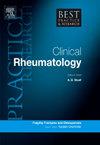Musculoskeletal manifestations in leprosy
IF 4.8
2区 医学
Q1 RHEUMATOLOGY
Best Practice & Research in Clinical Rheumatology
Pub Date : 2025-05-01
DOI:10.1016/j.berh.2025.102039
引用次数: 0
Abstract
Leprosy, a chronic infectious disease caused by Mycobacterium leprae and Mycobacterium lepromatosis, primarily targets the skin and peripheral nerves, frequently leading to dermatological, neurological, and musculoskeletal complications. This review highlights the spectrum of musculoskeletal manifestations in leprosy, including acute arthritis during Type 2 reactions, chronic arthritis mimicking autoimmune diseases like rheumatoid arthritis, and neuropathic arthropathy. These manifestations underscore the complex interplay of inflammatory and immune mechanisms. Acute arthritis often involves both small and large joints, while chronic forms may present diagnostic challenges due to their resemblance to other inflammatory arthritides. Clinical management centers on multidrug therapy (MDT) for infection control, complemented by immunosuppressive or anti-inflammatory agents for reactional episodes. Recent advancements, such as biologics and synthetic immunosuppressants, have demonstrated efficacy in refractory cases, offering new therapeutic avenues. Heightened clinician awareness is essential for timely diagnosis and integrated management, particularly in endemic regions, to mitigate long-term disabilities and improve patient outcomes.
麻风病的肌肉骨骼表现。
麻风是一种由麻风分枝杆菌和麻风分枝杆菌病引起的慢性传染病,主要以皮肤和周围神经为目标,经常导致皮肤、神经和肌肉骨骼并发症。这篇综述强调了麻风病的肌肉骨骼表现,包括2型反应期间的急性关节炎,模仿自身免疫性疾病(如类风湿关节炎)的慢性关节炎和神经性关节病。这些表现强调了炎症和免疫机制的复杂相互作用。急性关节炎通常涉及小关节和大关节,而慢性关节炎由于与其他炎症性关节炎相似,可能会带来诊断上的挑战。临床管理以多药治疗(MDT)控制感染为中心,辅以免疫抑制剂或抗炎剂治疗反应性发作。最近的进展,如生物制剂和合成免疫抑制剂,已证明对难治性病例有效,提供了新的治疗途径。提高临床医生的认识对于及时诊断和综合管理至关重要,特别是在流行地区,以减轻长期残疾和改善患者预后。
本文章由计算机程序翻译,如有差异,请以英文原文为准。
求助全文
约1分钟内获得全文
求助全文
来源期刊
CiteScore
9.40
自引率
0.00%
发文量
43
审稿时长
27 days
期刊介绍:
Evidence-based updates of best clinical practice across the spectrum of musculoskeletal conditions.
Best Practice & Research: Clinical Rheumatology keeps the clinician or trainee informed of the latest developments and current recommended practice in the rapidly advancing fields of musculoskeletal conditions and science.
The series provides a continuous update of current clinical practice. It is a topical serial publication that covers the spectrum of musculoskeletal conditions in a 4-year cycle. Each topic-based issue contains around 200 pages of practical, evidence-based review articles, which integrate the results from the latest original research with current clinical practice and thinking to provide a continuous update.
Each issue follows a problem-orientated approach that focuses on the key questions to be addressed, clearly defining what is known and not known. The review articles seek to address the clinical issues of diagnosis, treatment and patient management. Management is described in practical terms so that it can be applied to the individual patient. The serial is aimed at the physician in both practice and training.

 求助内容:
求助内容: 应助结果提醒方式:
应助结果提醒方式:


